Python - 深夜数据结构与算法之 DP 串讲
目录
一.引言
动态规划 DP 作为算法里比较晦涩难懂的一部分,我们这里多多复习几遍也不为过。本文主要重温递归、分治、回溯以及状态转移方程的概念,同时复习一下之前做过的题目。
二.DP 知识点回顾
1.递归
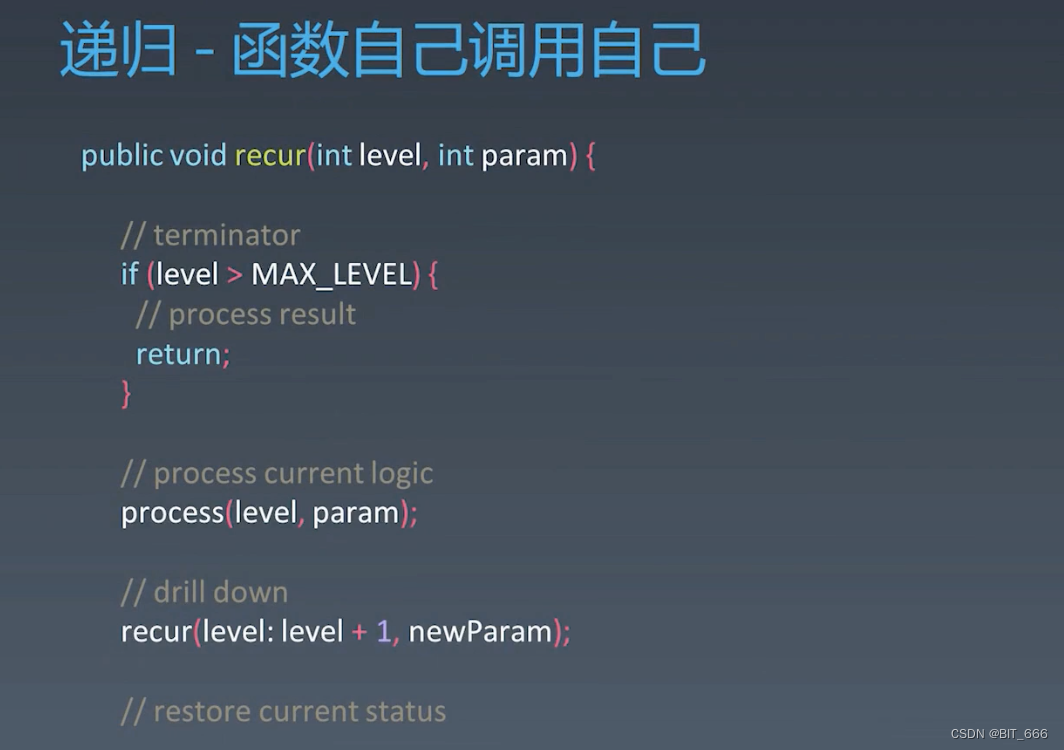
2.分治

3.动态规划
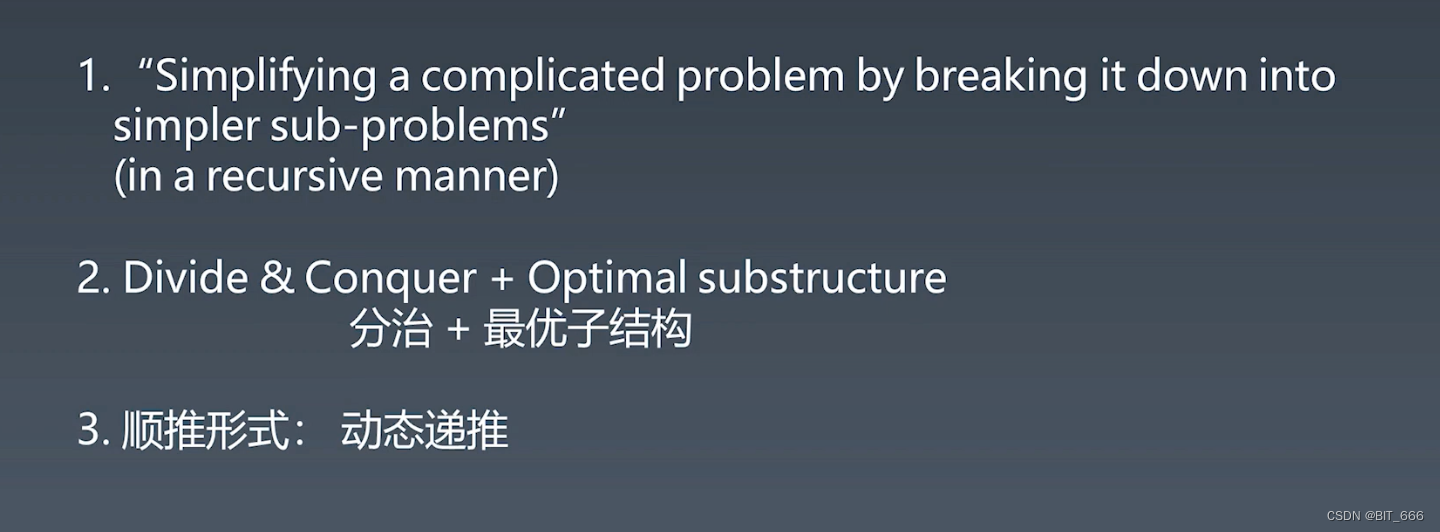
复杂的问题转换为子问题 - 分治 & 最优子结构 - 递推到 n :

三.DP 经典题目回顾
1.Climb-Stairs [70]
爬楼梯:?https://leetcode-cn.com/problems/climbing-stairs/

◆ 题目分析
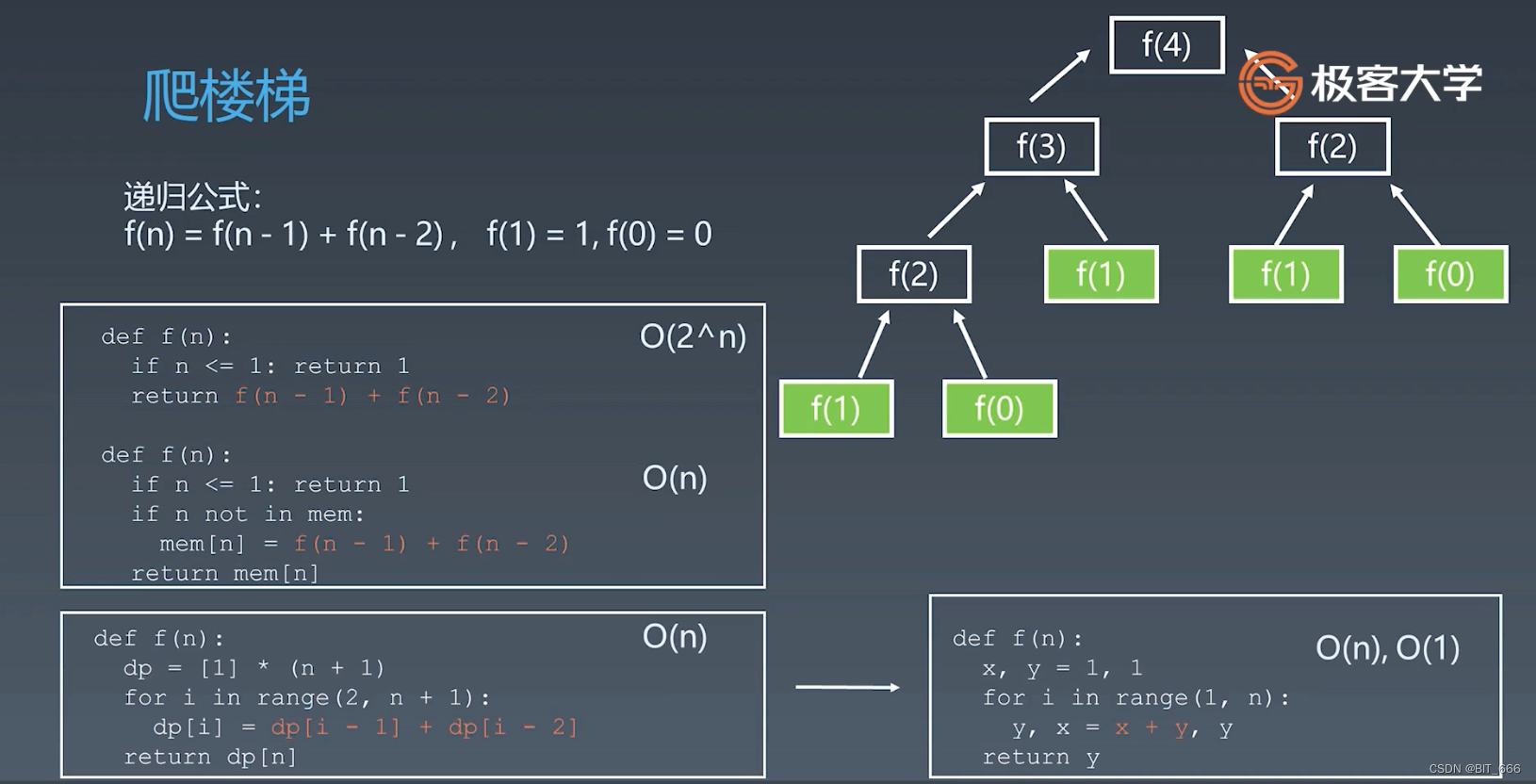
爬楼梯一次可以走1步或者2步,因此推导出 f(n) = f(n-1) + f(n-2),与 Fib 异曲同工。
◆ 傻递归
class Solution(object):
def climbStairs(self, n):
"""
:type n: int
:rtype: int
"""
if n <= 2:
return n
return self.climbStairs(n-1) + self.climbStairs(n-2)傻递归存在大量的重复计算,基本都会超时。?

◆ 递归 + Cache
class Solution(object):
def __init__(self):
self.mem = {0:0, 1:1, 2:2}
def climbStairs(self, n):
"""
:type n: int
:rtype: int
"""
if n in self.mem:
return self.mem[n]
steps = self.climbStairs(n-1) + self.climbStairs(n-2)
self.mem[n] = steps
return self.mem[n]加 Cache 的通法,在 init 初始化 cache,在傻递归返回的时候存入 cache 避免重复计算。?

◆ DP Table
class Solution(object):
def climbStairs(self, n):
"""
:type n: int
:rtype: int
"""
if n <= 2:
return n
a, b = 1, 2
for i in range(1, n):
a, b = b, a+b
return a使用 DP Table 时如果只使用有限个状态,一般都可以使用几个变量完成 dp 推进。?

2.Unique-Paths [62]
不同路径:?https://leetcode.cn/problems/unique-paths/
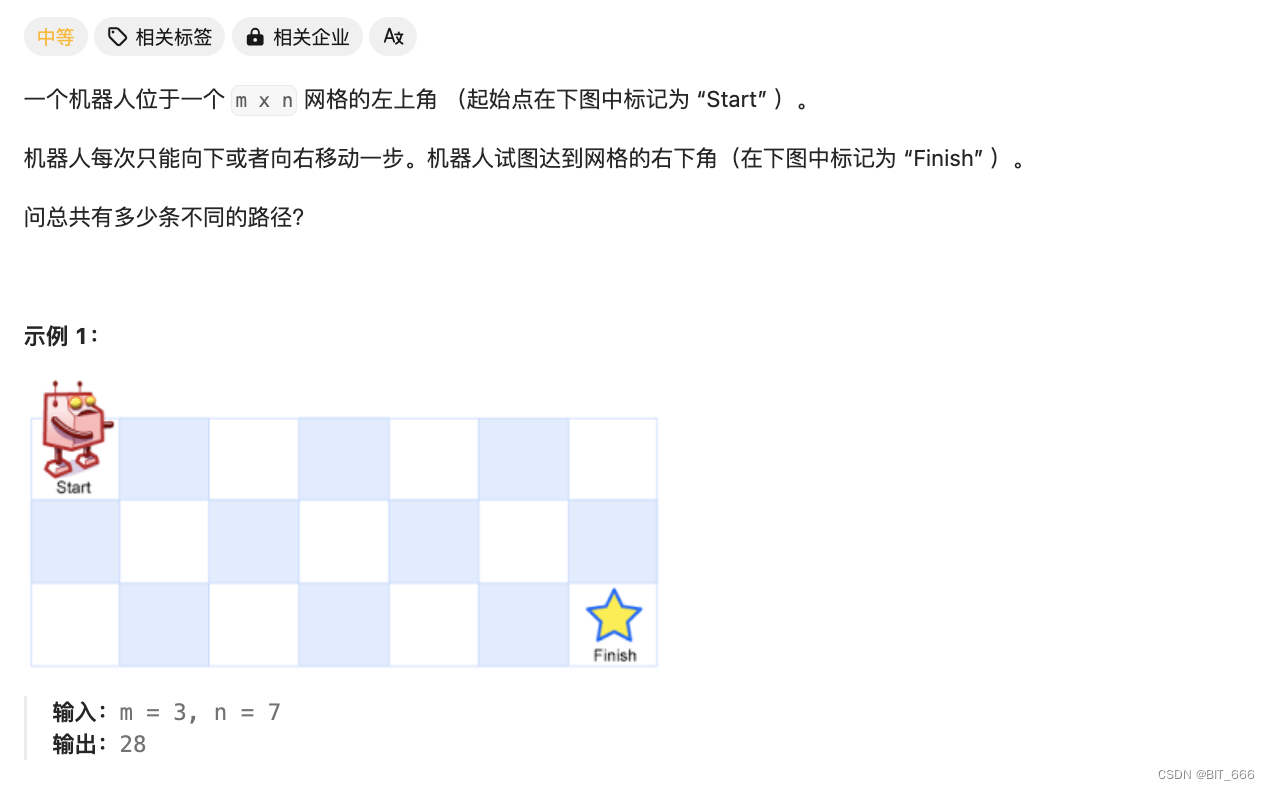
◆ 题目思路?
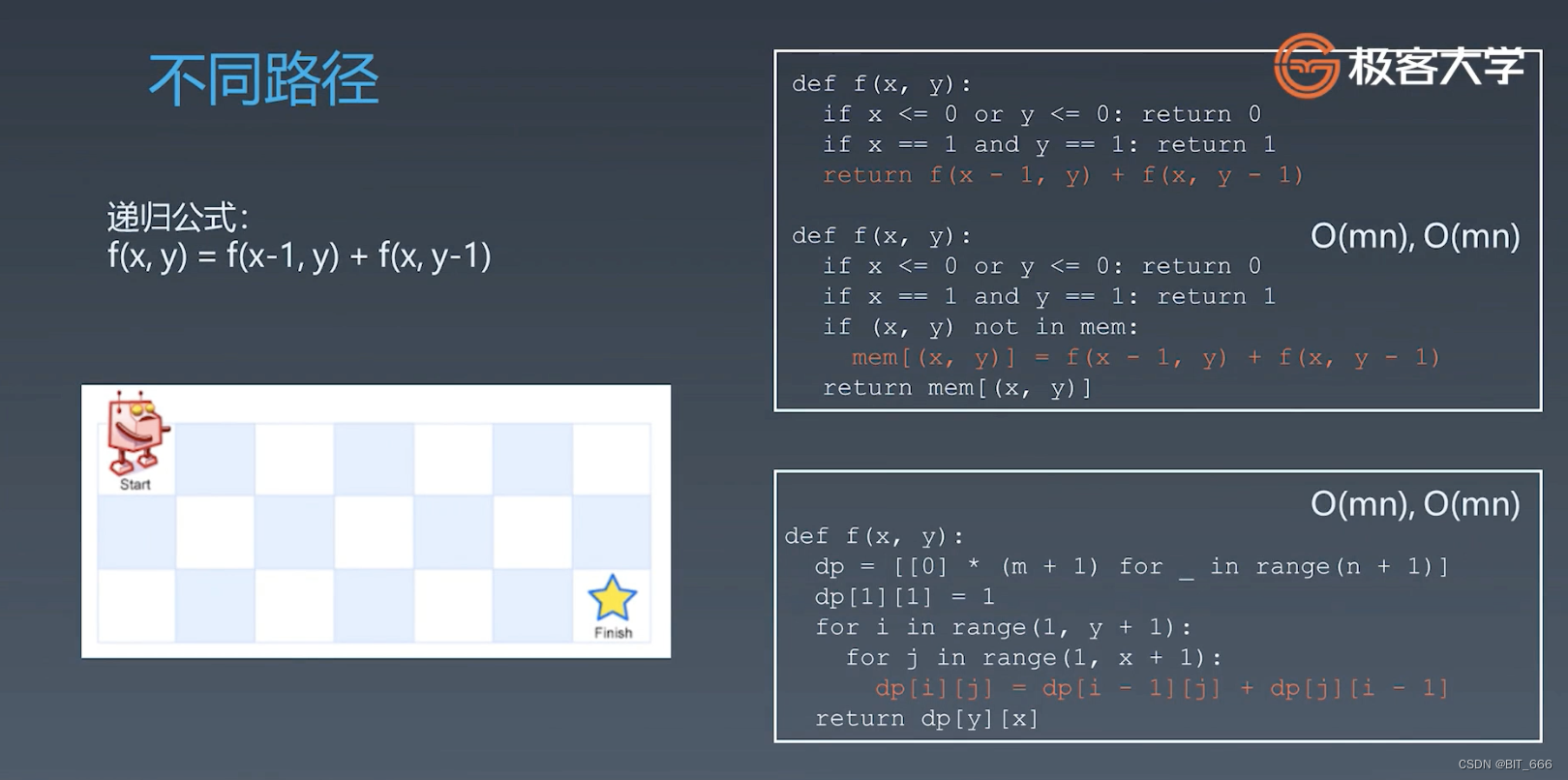
◆ DP Table
class Solution(object):
def uniquePaths(self, m, n):
"""
:type m: int
:type n: int
:rtype: int
"""
dp = [[0] * n for _ in range(m)]
for i in range(n):
dp[0][i] = 1
for j in range(m):
dp[j][0] = 1
for i in range(1, m):
for j in range(1, n):
dp[i][j] = dp[i-1][j] + dp[i][j-1]
return dp[m-1][n-1]dp[i][j] = dp[i-1][j] + dp[i][j-1] 即新位置等于左边和上面的位置之和。

◆ combination?
class Solution(object):
def uniquePaths(self, m, n):
"""
:type m: int
:type n: int
:rtype: int
"""
total = m + n - 2
# 减少计算量
if m > n:
k = n - 1
else:
k = m - 1
A = 1
F = 1
for i in range(k):
A *= total
total -= 1
F *= k
k -= 1
return A // F可以转化为排列组合问题,M+N-2 种走法,只要 M-1 向右,N-1?向下即可,直接套用?C(n,k)。
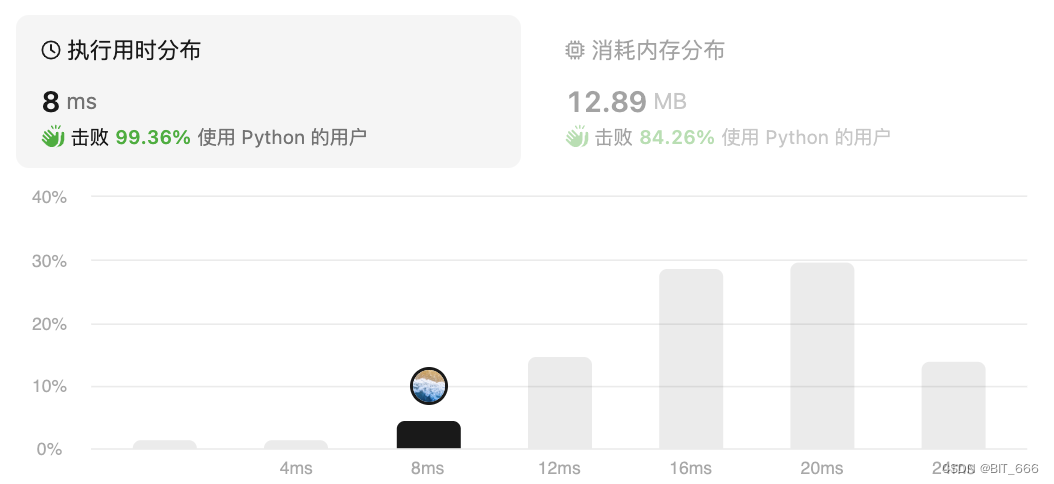
3.House-Robber [198]
打家劫舍:?https://leetcode-cn.com/problems/house-robber/
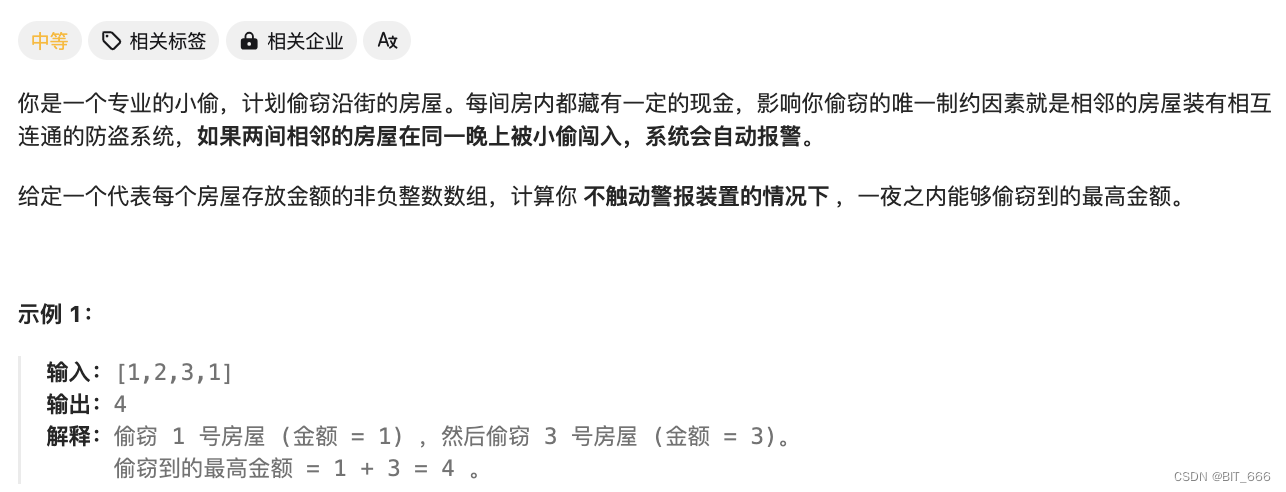
◆ 题目分析

◆ DP 转移
class Solution(object):
def rob(self, nums):
"""
:type nums: List[int]
:rtype: int
"""
# 两个状态代表偷不偷
dp = [[0, 0] for _ in range(len(nums))]
dp[0][1] = nums[0]
for i in range(1, len(nums)):
dp[i][0] = max(dp[i-1][0], dp[i-1][1])
dp[i][1] = dp[i-1][0] + nums[i]
return max(dp[-1][0], dp[-1][1])[0]、[1] 两个状态代表偷或者不偷,遍历即可。?

◆ 空间优化
class Solution(object):
def rob(self, nums):
"""
:type nums: List[int]
:rtype: int
"""
pre, now = 0, 0
for i in nums:
pre, now = now, max(pre + i, now)
return now
当前状态只与前两次状态有关,所以可以压缩 DP 状态空间。?
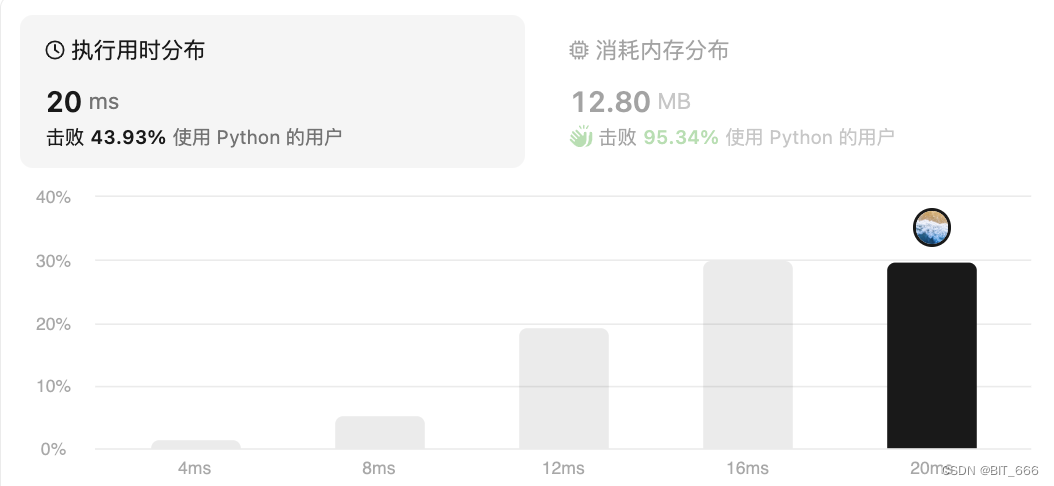
4.Min-Path-Sum [64]
最小路径和:?https://leetcode-cn.com/problems/minimum-path-sum/

◆ 题目分析

◆ DP 状态
class Solution(object):
def minPathSum(self, grid):
"""
:type grid: List[List[int]]
:rtype: int
"""
M, N = len(grid), len(grid[0])
# 遍历行
for col in range(1, N):
grid[0][col] += grid[0][col-1]
# 遍历行
for row in range(1, M):
grid[row][0] += grid[row - 1][0]
# 遍历内部元素
for row in range(1, M):
for col in range(1, N):
grid[row][col] += min(grid[row - 1][col], grid[row][col - 1])
return grid[M - 1][N - 1]每一步的最小值等于当前位置加上左边或上面的最小值。

5.Best-Time-Sell-Stock [121]
股票买卖:?https://leetcode-cn.com/problems/best-time-to-buy-and-sell-stock/
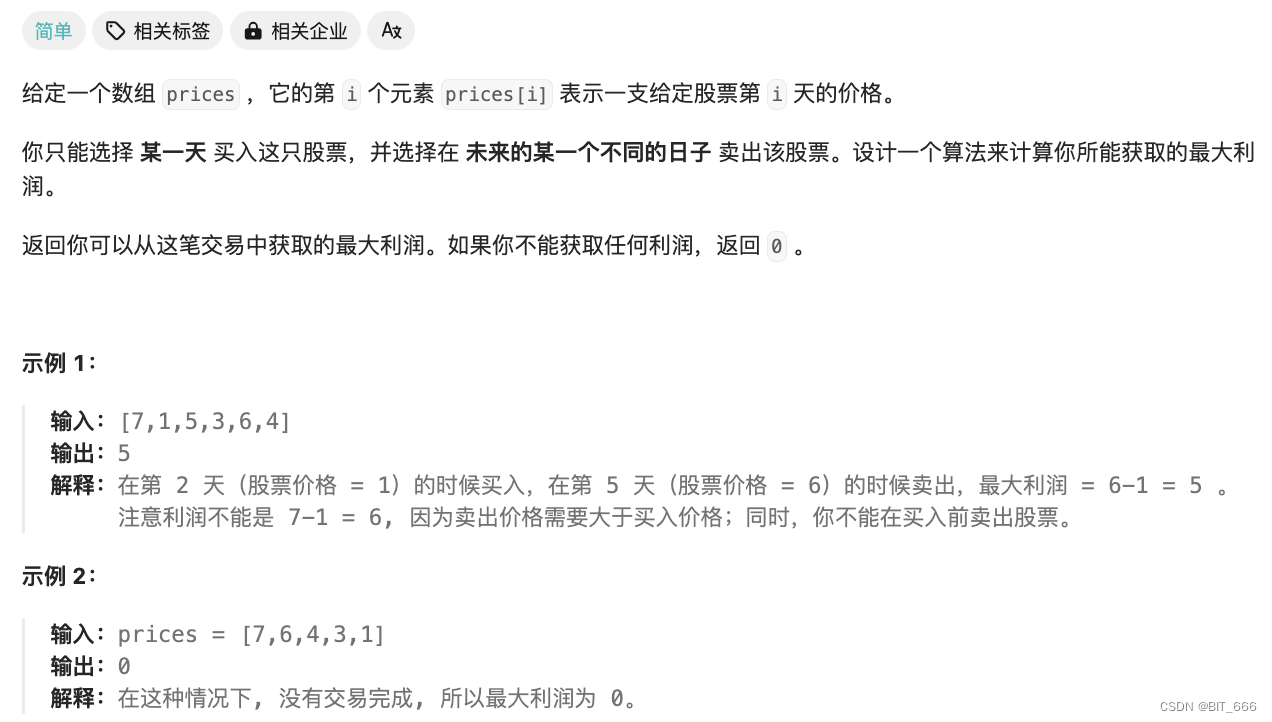
◆ 题目分析

上面为股票问题的 dp 套路模版,其中 dp 空间 i 为天数,k 为交易次数,s 为是否持有股票。

要维持没有股票的状态,只能 rest 或者卖,要维持有股票的状态,只能 rest 或者买。
rest 代表保持状态,buy 时因为要从 Profit 中付出代价,所以要减去 prices[i]。
◆ DP 状态
class Solution(object):
def maxProfit(self, prices):
"""
:type prices: List[int]
:rtype: int
"""
# dp[i] = max(dp[i] - pre_min, dp[i-1])
dp = [0] * len(prices)
pre_min = prices[0]
for i in range(1, len(prices)):
dp[i] = max(prices[i] - pre_min, dp[i-1])
if pre_min > prices[i]:
pre_min = prices[i]
return dp[-1]dp[i] = max(dp[i] - pre_min, dp[i-1]) 当前位置等于卖了和上一次的最大值。

◆ DP + 双指针
class Solution(object):
def maxProfit(self, prices):
"""
:type prices: List[int]
:rtype: int
"""
# dp[i] = max(dp[i] - pre_min, 0)
cur_min = prices[0]
cur_max = 0
for i in range(1, len(prices)):
cur_max = max(cur_max, prices[i] - cur_min)
cur_min = min(cur_min, prices[i])
return cur_max每次维护 max 和 min 即可。?

6.Min-Cost-Climb [746]
最小花费爬楼梯:?https://leetcode.cn/problems/min-cost-climbing-stairs/description/

◆ 题目分析
到达第 i 个楼梯,起点是 0 级或 1 级台阶。我们到达 i 级台阶的费用:
dp[i] = min(dp[i-1] + cost[i-1], dp[i-1] + cost[i-2])
由于起始点 0,1 都可以自由选择,所以其初始化为 0 。
?◆ DP 实现
class Solution(object):
def minCostClimbingStairs(self, cost):
"""
:type cost: List[int]
:rtype: int
"""
# dp[i] = min(dp[i-1] + cost[i-1], dp[i-2] + cost[i-1])
dp = [0] * (len(cost) + 1)
for i in range(2, len(cost) + 1):
dp[i] = min(dp[i - 1] + cost[i - 1], dp[i - 2] + cost[i - 2])
return dp[-1]这个题比较坑的点是楼顶对应索引 n,而索引从 0 开始,所以需要遍历 range(0, n+1)。不过题目的状态转移方程还是很漂亮,借鉴了前面爬楼梯的题目。?

7.Edit-Distance [72]
编辑距离:?https://leetcode-cn.com/problems/edit-distance/
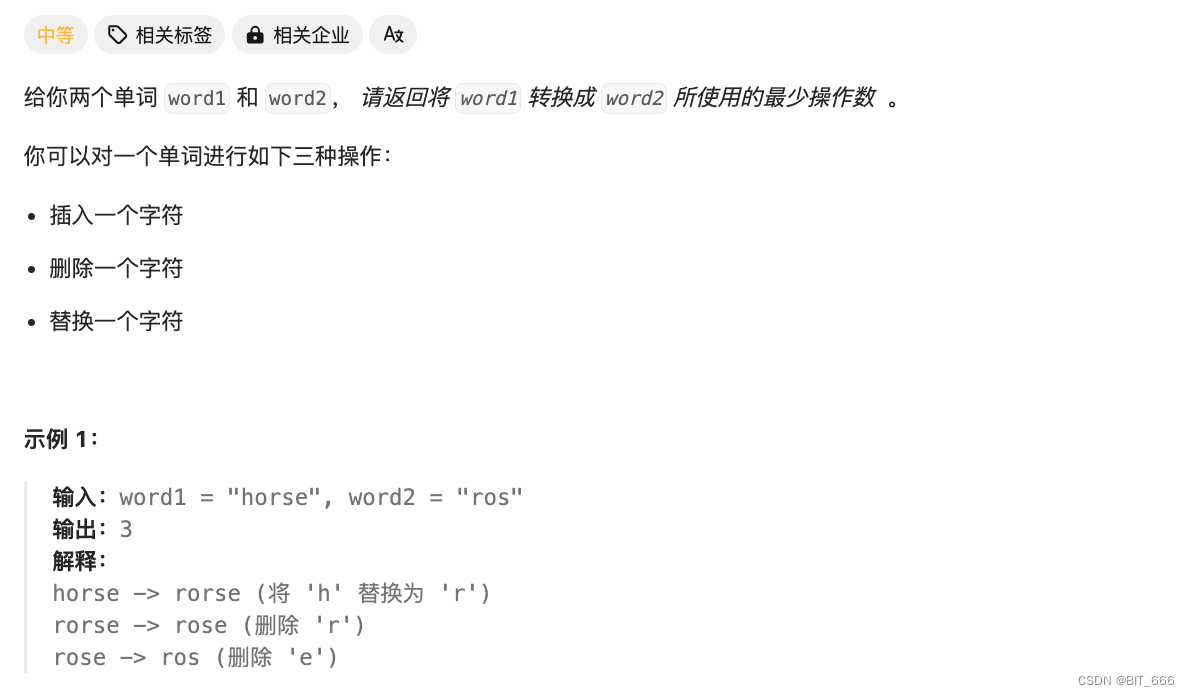
◆ 题目分析

?这个题和之前的单词接龙比较像,但是一拿到又无从下手,这里直接给出 DP 的思路,构建二维 DP 状态矩阵,大小为 [M+1, N+1],如果 w1[i] ==?w2[j] 字符相同,那么此处无需操作;否则我们需要借助插入、删除、替换的操作,这里插入和删除其实是相对的,无需严格的区分:
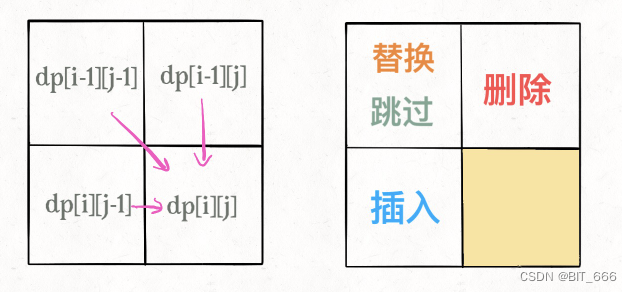
所以 dp[i][j] 的最小编辑距离就可以从 min(dp[i-1][j], dp[i][j-1], dp[i-1][j-1]) 里找最小再 + 1。这个题好写但是难想,把上面的 dp table 写出来更方便理解,这里理解不好就记忆好了,也不错。
◆ DP 实现
class Solution(object):
def minDistance(self, word1, word2):
"""
:type word1: str
:type word2: str
:rtype: int
"""
# w[i] = w[j] -> w[i][j] = w[i-1]w[j-1]
# w[i] != w[j] -> w[i][j] = min(w[i-1][j-1] + 1, w[i-1][j] + 1, w[i][j-1] +1)
M, N = len(word1), len(word2)
# 状态空间
dp = [[0] * (N + 1) for _ in range(M + 1)]
#
for i in range(M + 1):
dp[i][0] = i
for j in range(N + 1):
dp[0][j] = j
for i in range(1, M + 1):
for j in range(1, N + 1):
if word1[i - 1] == word2[j - 1]:
dp[i][j] = dp[i - 1][j - 1]
else:
dp[i][j] = min(dp[i - 1][j], dp[i][j - 1], dp[i - 1][j - 1]) + 1
return dp[-1][-1]
8.Longest-Sub-Seq [300]
?最长递增子序列:?https://leetcode.cn/problems/longest-increasing-subsequence
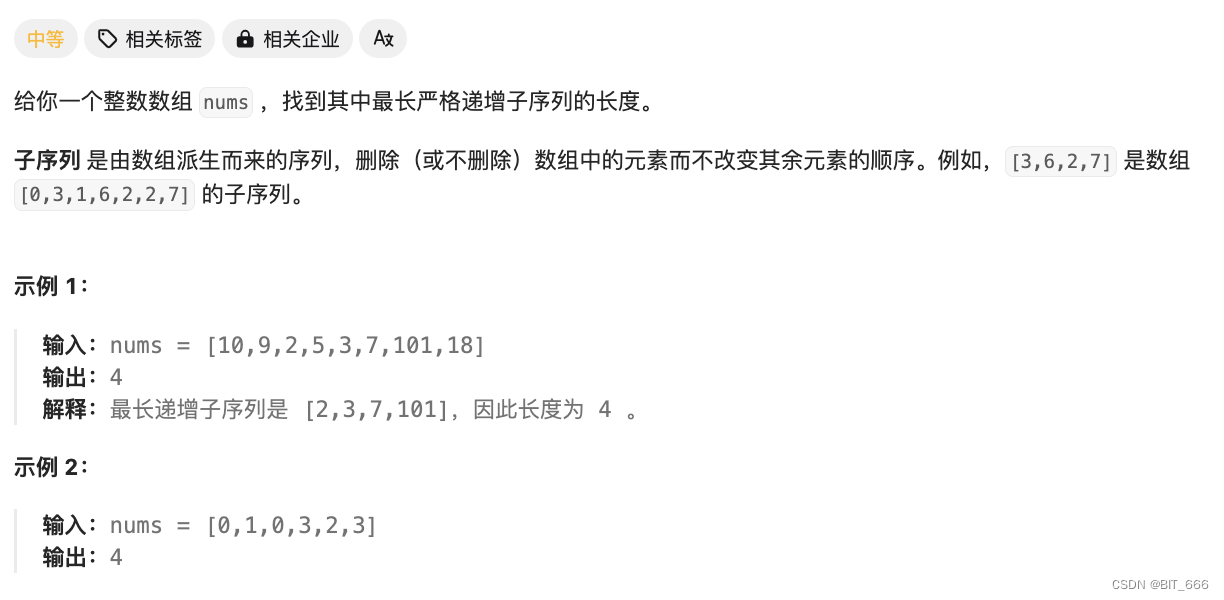
◆ 题目分析?

对于 i 位置,其等于 range(0, i) 之间的元素,如果 nums[i] > nums[j] 则?dp[i] = max_sub + 1。
◆ DP 实现
class Solution(object):
def lengthOfLIS(self, nums):
"""
:type nums: List[int]
:rtype: int
"""
dp = [1] * len(nums)
for i in range(1, len(nums)):
for j in range(0, i):
if nums[i] > nums[j]:
dp[i] = max(dp[i], dp[j] + 1)
return max(dp)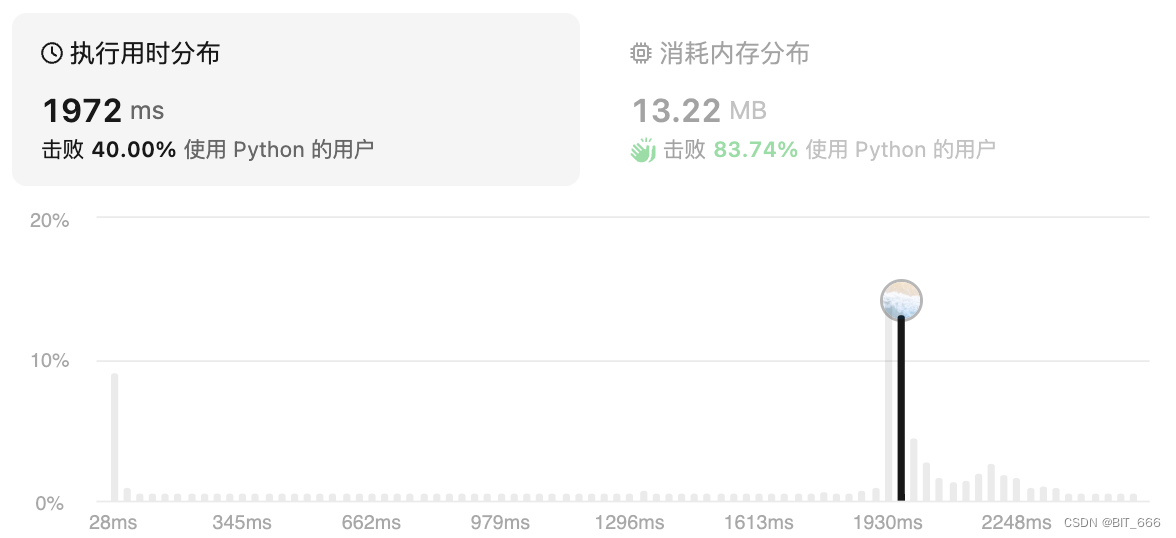
四.总结
如果同学们是看了前面 DP 和 DP 进阶并且做了习题的话,相信今天再看这一个章节会有一种醍醐灌顶,豁然开朗的状态,后面我们会继续讲解回顾高级 DP 动态规划问题。
本文来自互联网用户投稿,该文观点仅代表作者本人,不代表本站立场。本站仅提供信息存储空间服务,不拥有所有权,不承担相关法律责任。 如若内容造成侵权/违法违规/事实不符,请联系我的编程经验分享网邮箱:chenni525@qq.com进行投诉反馈,一经查实,立即删除!
- Python教程
- 深入理解 MySQL 中的 HAVING 关键字和聚合函数
- Qt之QChar编码(1)
- MyBatis入门基础篇
- 用Python脚本实现FFmpeg批量转换
- C++中的常见数据结构 --- 队列、栈、列表
- 字符流的输入输出,以及序列化与反序列化的基础知识
- petalinux2021.1 手动打包BOOT.BIN
- 禅道的基本使用
- 超声波眼镜清洗机清洗眼镜会有伤害吗?适合洗眼镜超声波清洗机
- Ask for Power Apps 消失了?
- 图片编辑软件好用?使用这些工具,你也可以修出文艺清新图片
- 我的2023
- docker学习(二十二、终篇,docker-compose)
- 优思学院|精益管理的目的和意义
